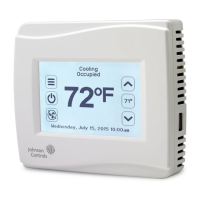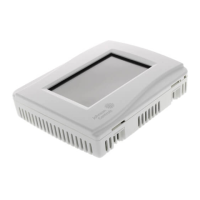TEC26x7-4 Series BACnet® MS/TP Networked Thermostat Controllers with Two Outputs Installation
Instructions
Technical Specifications
Table 7: Troubleshooting Details
1
Symptom Probable Causes
Multiple
Symptoms
Excessive bus errors may be occurring.
A device may have been added or changed with a duplicate address (may not be the same address as
some devices having problems, and may have happened sometime before the problem was noticed).
Wiring errors or wire problems may exist.
The baud rate may have been changed on some devices on the network, but not all devices.
Max_Master may have been changed incorrectly (may have happened sometime before the problem
was noticed).
A download may be in progress.
There may be a fault at a device.
A repeater may be needed or may be configured incorrectly.
There may be a duplicate device object name or instance.
Poor Performance See the probable causes listed previously in the Multiple Symptoms section of this table.
Excessive bus traffic may exist (bus overload).
The baud rate may be set too low.
There may be too many devices on the network.
There may be unaccounted devices on the network (not mapped to the NAE).
There may be unusually slow devices on the network or devices that are slow to respond.
Thermostat
Controller Goes
Offline
See the probable causes listed previously in the Multiple Symptoms section of this table.
A power failure or other failure may have occurred at the thermostat controller.
Communication may have been disabled at the thermostat controller.
Thermostat
Controller Does
Not Come Online
See the probable causes listed previously in the Multiple Symptoms section of this table.
A thermostat controller may be connected to the wrong bus.
A baud rate may be specified in the new thermostat controller that is incompatible with the running
network.
No device on the network is configured to use a specific baud rate (normally the NAE), but all devices
are set to use auto baud. At least one device, typically the bus supervisor (NAE), must have an
assigned baud rate. Set the baud rate in the bus supervisor and set all other devices to auto baud.
1. For common MS/TP troubleshooting information, refer to the MS/TP Communications Bus Technical Bulletin
(LIT-12011034).
TEC26x7-4 Series BACnet MS/TP Networked Thermostat Controllers with Two Outputs
(Part 1 of 2
)
Power Requirements 19 to 30 VAC, 50/60 Hz, 2 VA (Terminals 4 and 5) at 24 VAC Nominal, Class 2 or
Safety Extra-Low Voltage (SELV)
Relay/Triac
Contact
Rating
On/Off and
Floating
Control
19 to 30 VAC, 1.0 A Maximum, 15 mA Minimum, 3.0 A In-Rush, Class 2 or SELV
Analog
Output Rating
Proportional
Control
0 to 10 VDC into 2k ohm Resistance (Minimum)
Auxiliary
Output Rating
Triac Output 19 to 30 VAC, 1.0 A Maximum, 15 mA Minimum 3.0 A In-Rush
Binary Inputs Voltage-Free Contacts across Terminal Scom to Terminals BI1, BI2, or UI3
Analog Inputs Resistive Inputs (RS and UI3) for 10k ohm Johnson Controls Type II Negative
Temperature Coefficient (NTC) Thermistor Sensors
Temperature Sensor Type Local 10k ohm Negative Temperature Coefficient (NTC) Thermistor

